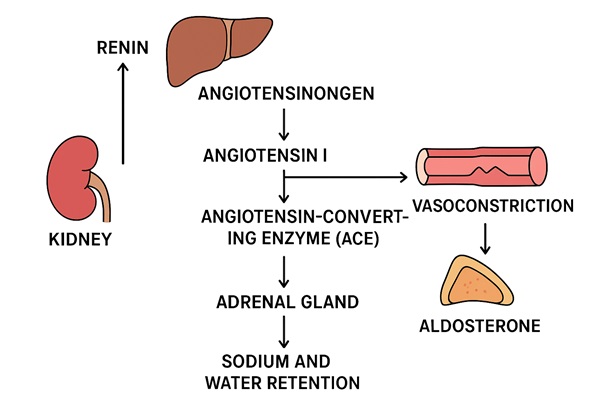Angiotensin Converting Enzyme (ACE):
Definition:
Angiotensin Converting Enzyme (ACE) is a key enzyme in the renin-angiotensin-aldosterone system (RAAS) — a hormonal system that regulates blood pressure, fluid balance, and electrolyte levels. It plays a vital role in cardiovascular and kidney function by converting angiotensin I (an inactive peptide) into angiotensin II (a potent vasoconstrictor).
Structure and Location
ACE is a zinc metallopeptidase, meaning it contains a zinc ion at its active site, which is essential for its enzymatic activity. It exists in two main forms:
-
Somatic ACE: Found in many tissues, especially in the lungs, endothelial cells, kidneys, and heart.
-
Testicular ACE: Found in the testes, involved in male fertility.
The highest concentration of ACE is in the lungs, where the enzyme converts circulating angiotensin I into angiotensin II as blood passes through pulmonary capillaries.
Functions of Angiotensin-Converting Enzyme
-
Conversion of Angiotensin I to Angiotensin II:
-
ACE converts the inactive angiotensin I (a decapeptide) into angiotensin II (an octapeptide) by removing two amino acids.
-
Angiotensin II is a powerful vasoconstrictor, meaning it narrows blood vessels, leading to an increase in blood pressure.
-
-
Inactivation of Bradykinin:
-
ACE also breaks down bradykinin, a peptide that promotes vasodilation (widening of blood vessels).
-
By inactivating bradykinin, ACE contributes further to vasoconstriction and elevated blood pressure.
-
Role in the Renin-Angiotensin-Aldosterone System (RAAS)
The RAAS is a hormonal cascade that maintains blood pressure and fluid balance:
-
Renin release: When blood pressure or sodium levels drop, the kidneys release renin.
-
Angiotensinogen conversion: Renin converts angiotensinogen (from the liver) into angiotensin I.
-
ACE activity: ACE converts angiotensin I into angiotensin II.
-
Effects of Angiotensin II:
-
Causes vasoconstriction (narrowing of arteries), increasing blood pressure.
-
Stimulates the adrenal glands to release aldosterone, promoting sodium and water retention by the kidneys.
-
Triggers the release of antidiuretic hormone (ADH), which also increases water reabsorption.
-
Together, these effects raise blood volume and blood pressure, restoring homeostasis.
Clinical Importance
1. ACE Inhibitors:
-
ACE inhibitors are drugs that block the action of ACE, preventing the formation of angiotensin II.
-
This leads to:
-
Vasodilation (widening of blood vessels)
-
Decreased blood pressure
-
Reduced fluid retention
-
Common ACE inhibitors include:
-
Captopril
-
Enalapril
-
Lisinopril
-
Ramipril
Used to treat:
-
Hypertension (high blood pressure)
-
Congestive heart failure
-
Chronic kidney disease (especially in diabetics)
-
Myocardial infarction (heart attack) recovery
2. Side Effects of ACE Inhibitors:
-
Dry cough (due to accumulation of bradykinin)
-
Hyperkalemia (elevated potassium levels)
-
Hypotension (especially after the first dose)
-
Angioedema (rare but serious allergic swelling)
Biochemical Mechanism
ACE catalyzes the cleavage of a dipeptide from the C-terminal end of angiotensin I.
Reaction:
AngiotensinI→AngiotensinII+His−LeuAngiotensin I → Angiotensin II + His-Leu
This reaction is dependent on zinc (Zn²⁺) at the active site, which stabilizes the peptide substrate and facilitates the hydrolysis reaction.
Summary Table
| Aspect | Details |
|---|---|
| Full Name | Angiotensin-Converting Enzyme |
| Type | Zinc metallopeptidase |
| Main Locations | Lungs, kidneys, endothelium, heart |
| Main Functions | Converts Angiotensin I → Angiotensin II; Degrades Bradykinin |
| Physiological Role | Regulates blood pressure and fluid balance via RAAS |
| Clinical Target | ACE inhibitors used in hypertension and heart failure |
Conclusion
Angiotensin-Converting Enzyme (ACE) is central to blood pressure regulation and cardiovascular homeostasis. By generating angiotensin II and inactivating bradykinin, ACE promotes vasoconstriction and sodium retention. Understanding ACE has led to major advances in treating hypertension, heart failure, and kidney disease through the development of ACE inhibitors — one of the most important classes of cardiovascular drugs in modern medicine.
